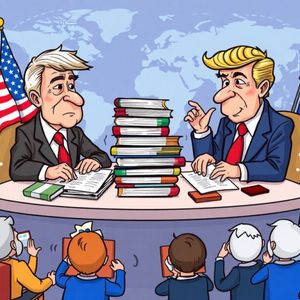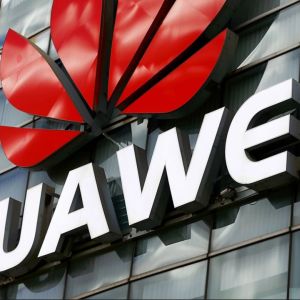BitcoinWorld US Trade Deals Unveiled: Critical Shifts in Global Commerce In the dynamic landscape of international commerce, few announcements capture attention quite like shifts in US trade deals . On July 27, then-U.S. President Donald Trump made statements during a meeting in Scotland that signaled a pivotal moment in America’s approach to global trade. His declaration that the U.S. was actively pursuing new trade agreements with “three or four countries,” while simultaneously preparing to issue tariff notices to smaller economies, underscored a bold strategy. This approach, characterized by a willingness to leverage tariffs as a negotiation tool, aimed to reshape how nations interacted economically, impacting industries from automotive to pharmaceuticals. Understanding these developments is crucial for grasping the complexities of modern global finance. What Were the Key Announcements Regarding US Trade Deals? During his meeting with European Commission President Ursula von der Leyen, President Trump outlined a multi-faceted strategy concerning US trade deals . He indicated the U.S. was actively engaged in discussions for significant agreements with “three or four nations,” signaling a shift towards tailored bilateral negotiations. Concurrently, smaller economies, perceived as having unfair trade practices, would receive “tariff notices,” using economic leverage to compel reassessment of their policies. A concrete outcome from this period was the agreement between the U.S. and the European Union. Senior U.S. officials confirmed a 15% tariff on most EU exports to the U.S., including high-value goods like automobiles and pharmaceuticals. This was framed around addressing perceived imbalances and protecting domestic industries. Furthermore, strategic sectors faced steeper levies. Steel and aluminum exports from the EU were slated to remain subject to a substantial 50% tariff. This reflected concerns about global overcapacity and a desire to bolster American production, deemed critical for national security. These announcements collectively showcased an administration unafraid to challenge established trade norms, willing to renegotiate terms, and ready to employ tariffs as a primary instrument to achieve its economic objectives. How Did These US Trade Deals Aim to Reshape Global Commerce? The pursuit of these specific US trade deals and the broader application of tariffs were integral components of the “America First” economic philosophy. This strategy sought to fundamentally recalibrate global economic relationships by prioritizing domestic interests. The administration aimed to address decades of perceived unfair trade practices, trade deficits, and the erosion of American manufacturing jobs. By initiating bilateral negotiations, the U.S. sought to craft agreements tailored to its unique economic needs, allowing for greater leverage in individual discussions than in larger multilateral forums. The strategic use of tariffs was a central pillar, designed to: Force Renegotiation: Economic pressure from tariffs aimed to compel trading partners to seek more favorable terms. Protect Domestic Industries: Higher import costs theoretically boosted demand for American-made goods, safeguarding jobs in sectors like steel and automotive. Reduce Trade Deficits: The ultimate goal was to decrease the imbalance between U.S. imports and exports, retaining wealth within the country. This aggressive stance departed significantly from the post-World War II consensus on free trade, embracing a more protectionist approach. The intent was to create a more level playing field, or even an advantageous one, for American businesses by rewriting international commerce rules. The ripple effects prompted other nations to consider defensive measures and re-evaluate their trade relationships with the United States. What Were the Anticipated Benefits of These US Trade Deals? From the administration’s perspective, the assertive pursuit of new US trade deals and the strategic application of tariffs were expected to yield several significant benefits for the American economy. A primary expected benefit was the revitalization of domestic industries . Tariffs on imported goods like steel, aluminum, and automobiles aimed to make foreign products more expensive, increasing the competitiveness of American-made goods. This was crucial for sectors challenged by global competition, with the hope of stimulating investment, reopening plants, and creating jobs. Furthermore, these policies were designed to reduce the U.S. trade deficit . Viewing persistent deficits as a sign of economic weakness, the goal was to decrease imports and boost exports, narrowing the trade gap and retaining wealth within the country. Another anticipated advantage was enhanced national security . The argument posited that reliance on foreign sources for critical materials posed risks. Strengthening domestic production through tariffs aimed to ensure self-sufficiency in vital sectors, reducing vulnerability to geopolitical shifts. Moreover, the administration believed its assertive posture would compel other nations to address unfair trade practices , such as intellectual property theft and non-tariff barriers. By demonstrating a willingness to impose tariffs, the U.S. sought to pressure partners into fairer, more reciprocal trade relationships, benefiting American innovators and businesses seeking global market access. Finally, pursuing bilateral US trade deals allowed for greater flexibility, tailoring agreements precisely to American interests. This aimed to secure better terms for specific American agricultural products, manufactured goods, and services, opening new export opportunities and strengthening key U.S. economic sectors. What Challenges and Criticisms Emerged from These US Trade Deals? While the Trump administration championed its US trade deals , these policies also faced significant challenges and drew widespread criticism. The ripple effects impacted industries, consumers, and geopolitical relationships. One major concern was the potential for increased costs for American consumers and businesses . Tariffs, essentially taxes on imports, often led to higher prices for consumers. For businesses reliant on imported components, tariffs increased production costs, eroding profit margins or forcing price hikes, potentially reducing demand. Another significant challenge was the likelihood of retaliatory tariffs from trading partners . When the U.S. imposed tariffs, other nations often responded in kind, targeting American exports. This tit-for-tat dynamic could escalate into a full-blown trade war, harming American farmers and exporters and negating initial tariff benefits. The disruption to established global supply chains was also a major criticism. Sudden tariff changes forced companies to rethink sourcing, leading to costly adjustments or production relocation. This uncertainty deterred investment and hindered economic growth. Furthermore, the aggressive trade stance strained relationships with key allies like Canada, Mexico, and European nations. Being on the receiving end of tariffs created diplomatic friction and undermined crucial alliances. Critics argued this could weaken the U.S.’s overall standing. Finally, concerns arose about the impact on global economic growth . Trade disputes and protectionist policies could reduce trade volumes, stifle innovation, and create uncertainty, potentially leading to a slowdown in global economic activity affecting all nations. Navigating the Future: Actionable Insights from US Trade Deals The period characterized by a renewed focus on US trade deals and the assertive use of tariffs offers valuable lessons for businesses, policymakers, and consumers. Understanding these dynamics is crucial for navigating the evolving landscape of international commerce. For businesses, the primary insight is the imperative of resilience and adaptability . Companies learned that relying solely on optimized global supply chains could be risky. Actionable steps include: Diversifying Supply Chains: Exploring alternative sourcing to mitigate risks. Monitoring Policy Changes: Staying abreast of negotiations and announcements to anticipate impacts. Engaging with Policymakers: Advocating for industry interests and providing data on policy impact. Building Financial Buffers: Preparing for potential cost increases due to tariffs. For policymakers, the experience highlighted the delicate balance between protecting domestic industries and maintaining stable international relations. It underscored the need for: Careful Impact Assessments: Analyzing downstream effects of tariffs on various sectors and consumers. Strategic Communication: Clearly articulating policy goals to stakeholders. Multilateral Engagement: Recognizing that global stability often benefits from broader cooperative frameworks. Consumers gained insights into how trade policies directly impact their wallets, realizing that tariffs can lead to higher prices and shifts in product availability. Ultimately, the intensified focus on US trade deals served as a powerful reminder that international trade is complex, influenced by economic theory, political ideology, and geopolitical realities. These decisions have far-reaching consequences, shaping not only national economies but also global cooperation. The lessons from this era remain highly relevant for understanding future trade trajectories. In summary, then-President Donald Trump’s July 27 announcements on US trade deals marked a definitive shift in America’s trade policy. Pursuing new agreements with “three or four nations” and applying tariffs to smaller economies, notably a 15% tariff on most EU exports and 50% on steel and aluminum, aimed to prioritize domestic industries and compel fairer trade. While proponents envisioned revitalized American manufacturing and enhanced national security, the approach also triggered significant challenges, including increased consumer costs, retaliatory tariffs, supply chain disruptions, and strained international relations. This period underscored the profound impact of trade policies on global commerce, prompting businesses to adapt, policymakers to reassess, and consumers to become more aware of the intricate connections between international agreements and their daily lives. The legacy of these bold trade maneuvers continues to shape discussions on globalization and international economic cooperation. Frequently Asked Questions (FAQs) 1. What was the primary goal of President Trump’s trade strategy regarding US trade deals? President Trump’s primary goal was to prioritize “America First” by reducing trade deficits, protecting domestic industries through tariffs, and compelling other nations to engage in what he considered fairer, more reciprocal trade practices. 2. Which specific products were affected by the U.S.-EU tariff agreement mentioned? According to the report, the agreement included a 15% tariff on most EU exports to the U.S., notably including cars and pharmaceuticals. Steel and aluminum exports from the EU remained subject to a 50% tariff. 3. How did the “America First” policy influence US trade deals? The “America First” policy led to a shift from multilateral trade agreements to bilateral negotiations, allowing the U.S. to leverage its economic power to secure terms perceived as more favorable to American businesses and workers, often through the strategic use of tariffs. 4. What were some of the key criticisms leveled against these trade policies? Key criticisms included potential increases in costs for American consumers and businesses due to tariffs, the risk of retaliatory tariffs from trading partners, disruption to global supply chains, and strained relationships with key international allies. 5. Did these trade policies lead to new trade agreements? Yes, while the July 27 announcement mentioned pursuing deals with “three or four nations,” the broader administration did pursue and finalize new trade agreements, such as the USMCA (United States-Mexico-Canada Agreement) replacing NAFTA, and a “Phase One” trade deal with China, alongside other smaller agreements. 6. How did these trade policies impact average consumers? Average consumers could experience higher prices for imported goods due to tariffs, as these costs were often passed down. Additionally, there could be shifts in product availability or variety as companies adjusted their sourcing and supply chains in response to the new trade environment. Did you find this deep dive into US trade deals insightful? Share this article on your social media channels to spark a conversation about the complexities of global commerce and its impact on economies worldwide! To learn more about the latest global economic policies and their impact on various sectors, explore our articles on key developments shaping international markets and future trends. This post US Trade Deals Unveiled: Critical Shifts in Global Commerce first appeared on BitcoinWorld and is written by Editorial Team














